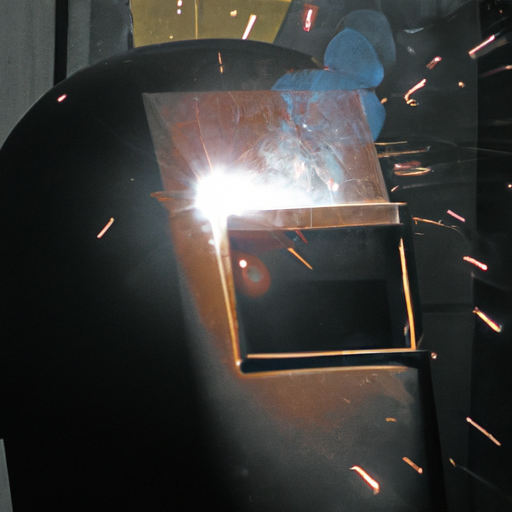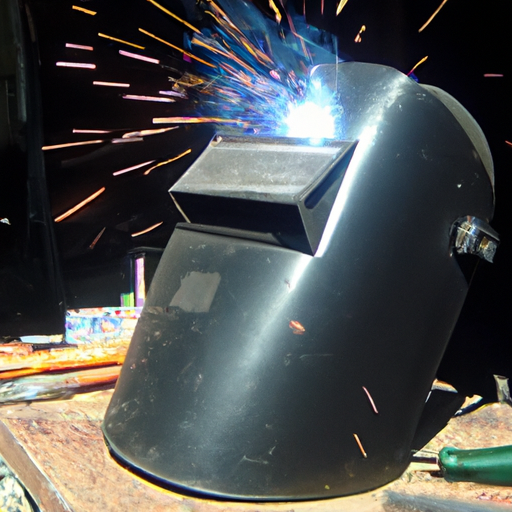Have you ever wondered if you could learn the art of welding on your own? In this article, we explore the fascinating question of whether welding can be self-taught. Many aspiring welders often feel hesitant about embarking on this skill without formal training or assistance, but we’ll delve into the possibilities and provide you with some valuable insights. Whether you’re a DIY enthusiast or simply curious about learning a new skill, read on to discover the secrets behind self-taught welding and how you can make it a reality.

Understanding Welding
Definition of Welding
Welding is a process that involves joining materials, typically metals, by melting them together and allowing them to cool and solidify. It is a crucial skill in various industries, including construction, manufacturing, and automotive. By creating a strong bond between materials, welding provides structural integrity and allows for the fabrication of complex structures.
Types of Welding
There are several types of welding techniques, each suited for different applications and materials. The most common types include:
-
Arc Welding: This method uses an electric current to create an arc between an electrode and the base material, resulting in a weld. It is widely used due to its versatility and low cost.
-
MIG/Flux-Cored Welding: MIG (Metal Inert Gas) and Flux-Cored Welding involve the use of a continuously fed wire electrode to create a weld. MIG welding uses a shielding gas, while flux-cored welding utilizes a flux-cored wire, allowing for high-speed and efficient welding.
-
TIG Welding: TIG (Tungsten Inert Gas) Welding uses a non-consumable tungsten electrode to produce the weld. This technique provides high-quality and precise welds, making it suitable for delicate or critical applications.
-
Oxy-Fuel Welding: This method combines a fuel gas, such as acetylene, with oxygen to generate a high-temperature flame for melting and joining metals.
Basic Principles of Welding
Understanding the fundamental principles of welding is essential for successful welds. These principles include:
-
Melting Point: Welding involves melting the base materials to create a weld pool. It is crucial to know the melting points of the materials involved to ensure proper fusion.
-
Heat Control: Controlling the heat input is vital to prevent distortion or weakening of the materials. The welding technique, current, and travel speed all play a role in heat control.
-
Shielding: To protect the weld from the surrounding atmosphere, a shielding gas or flux is used. This prevents oxidation and contamination, ensuring a strong and durable weld.
-
Electrode Selection: The choice of electrode depends on the welding technique and the material being welded. Different electrodes provide specific benefits, such as deeper penetration or cleaner welds.
Welding Safety Precautions
Welding can be hazardous if proper safety precautions are not followed. Some essential safety considerations include:
-
Personal Protective Equipment: Always wear appropriate safety gear, such as welding helmets, goggles, gloves, and protective clothing, to shield yourself from sparks, UV radiation, and flying debris.
-
Ventilation: Welding produces hazardous fumes and gases. Ensure proper ventilation in the workspace to prevent inhalation of toxic substances.
-
Fire Prevention: Welding involves high heat, so keep a fire extinguisher nearby and clear any flammable materials from the working area.
-
Electrical Safety: Be aware of electrical hazards and never touch live parts of welding equipment without proper insulation and protection.
The Self-Taught Approach
Overview of Self-Teaching
Self-teaching is a popular approach for learning welding. It involves taking the initiative to acquire the necessary knowledge and skills independently, rather than relying on formal education or training programs. This approach allows individuals to learn at their own pace and focus on specific areas of interest or need.
Pros and Cons of Self-Teaching
self-teaching welding offers several advantages, including flexibility in scheduling, cost-effectiveness, and the ability to tailor the learning process to personal preferences. It allows individuals to explore different resources, experiment, and discover their own learning methods. However, it is important to acknowledge the potential drawbacks, such as the lack of structured curriculum and limited access to expert guidance.
The Importance of Motivation and Discipline
Self-teaching welding requires motivation and discipline. Without external pressure or deadlines, it can be challenging to stay committed to regular practice and learning. Setting clear goals, creating a study schedule, and staying motivated by tracking progress are essential for success.
Skills Needed for Self-Teaching
To effectively self-teach welding, certain skills are beneficial:
-
Research Skills: Being able to find reliable sources of information, such as books, online resources, and forums, is crucial for gathering knowledge and learning new techniques.
-
Problem-Solving Skills: Welding often involves overcoming obstacles and finding solutions to welding challenges. Developing strong problem-solving skills will support your self-teaching journey.
-
Patience and Perseverance: Welding can be demanding, both physically and mentally. Patience and perseverance are key traits that will help you overcome difficulties and make progress.
-
Critical Thinking: Analyzing welding techniques and understanding the underlying principles require critical thinking skills. This enables you to evaluate your own work and make improvements.
Learning Welding Theories Online
Choosing Suitable Online Resources
With the abundance of information available online, it is essential to choose reliable and reputable resources for learning welding theories. Look for well-established websites, welding forums, and instructional videos created by experienced welders or industry professionals. Check for user reviews and ratings to ensure the quality and accuracy of the content.
Online Welding Courses
Online welding courses offer structured learning opportunities for self-taught welders. These courses cover a wide range of topics, from basic welding principles to advanced techniques. Look for courses that provide comprehensive lessons, interactive exercises, and opportunities for feedback from instructors or fellow students.
Online Welding Tutorials and Videos
Online tutorials and videos are an invaluable resource for self-taught welders. They allow you to visually see welding techniques demonstrated and provide step-by-step instructions for specific projects or challenges. Platforms such as YouTube and welding-focused websites offer a vast library of welding tutorials and videos, catering to beginners and experienced welders alike.
Using Online Welding Forums and Communities
Engaging with online welding forums and communities can provide valuable insights and guidance. These platforms allow you to connect with fellow welders, ask questions, and seek advice. Active participation in these communities can foster a supportive learning environment and expose you to different perspectives and experiences.
Online Safety Training
Safety should be a top priority when learning welding. Online safety training courses specifically designed for welders are available and cover essential topics such as the safe use of welding equipment, hazard recognition, and proper protective gear. Completing these courses will help you develop a strong safety mindset and minimize the risks associated with welding.
Acquiring a Welding Kit
Choosing the Right Welding Equipment
Choosing the right welding equipment is crucial for your journey as a self-taught welder. Consider factors such as the type of welding you intend to pursue, the thickness of the materials you will be working with, and your budget. Research different welding machines and compare their features, capabilities, and user reviews to make an informed decision.
Essential Tools for Welding Beginners
In addition to a welding machine, there are several essential tools you will need as a welding beginner:
-
Welding Helmet: Protects your eyes and face from sparks and harmful UV radiation.
-
Welding Gloves: Heavy-duty gloves that shield your hands from heat, sparks, and molten metal.
-
Chipping Hammer and Wire Brush: These tools are used to remove slag and clean the weld area, ensuring proper fusion.
-
Clamps and Magnets: Help hold the workpieces in place during welding, ensuring accuracy and stability.
Understanding the Functions of the Welding Kit
It is important to understand how the different components of your welding kit work together. Familiarize yourself with the controls, settings, and adjustments of your welding machine. Learn how to set the appropriate amperage, voltage, and wire feed speed for different welding applications. Understanding the functions of your welding kit will enable you to optimize its usage and achieve better results.
Safety Equipment Needed
Besides personal protective equipment (PPE) like a welding helmet and gloves, there are other safety equipment items you should have:
-
Fire Extinguisher: A fire extinguisher is essential to have in case of welding-related fires.
-
Welding Jacket: A welding jacket provides additional protection from sparks, UV radiation, and molten metal.
-
Welding Curtains or Screens: These barriers protect bystanders or other workers from the hazards of welding, such as UV radiation and sparks.
-
Welding Respirator: Used to protect against fumes and gases produced during welding, a respirator is crucial for maintaining lung health.

Practicing Basic Welding Skills
Setting Up the Welding Machine
Before starting your welding practice, make sure to set up your welding machine correctly. This includes connecting the power source, choosing the appropriate welding technique, and adjusting the settings based on the material thickness and type of electrode. Follow the manufacturer’s instructions and consult online resources for guidance if needed.
Practicing Welding Joints
Welding joints are the connections between two or more pieces of metal. Practice different types of joints, such as butt, lap, T, and corner joints, to develop your skills in creating strong and reliable welds. Experiment with different welding techniques and electrode positions to understand how they affect the quality and appearance of the weld.
Improving Welding Techniques
Consistent practice is key to improving your welding techniques. Focus on developing steady hand control, maintaining a consistent travel speed, and achieving proper penetration. Pay attention to the appearance of the weld, such as the bead shape, uniformity, and absence of defects. Continuously adjust and refine your technique based on your observations and feedback.
Analyzing and Fixing Welding Mistakes
Mistakes are a natural part of the learning process. Take the time to analyze your welds and identify any mistakes or areas for improvement. Common welding mistakes include insufficient penetration, excessive spatter, and improperly sized weld beads. Use online resources, forums, or seek feedback from experienced welders to learn how to rectify these mistakes and avoid repeating them in the future.
Achieving Mastery Through Practice
Developing a Regular Practice Routine
Consistency is key when it comes to mastering welding skills. Develop a regular practice routine that suits your schedule and commit to it. Set aside dedicated time for welding practice and stick to your schedule as much as possible. Regular practice will help you build muscle memory, improve hand-eye coordination, and refine your welding techniques.
Tracking Progress and Improvement
Track your progress and improvement throughout your self-teaching journey. Keep a record of the projects you’ve completed, the techniques you’ve learned, and any milestones or breakthroughs. Periodically revisit early welds to see how far you’ve come in terms of quality and proficiency. Reflection on progress can be a powerful motivator and a reminder of the progress you have made, even if it may seem slow at times.
Challenges Faced During Practice
Welding presents various challenges, and it is important to anticipate and address them. Common challenges include controlling the heat input, managing distortion, and achieving consistent penetration. Embrace these challenges as opportunities for growth and learning. By identifying and understanding the challenges you face, you can seek resources and strategies to overcome them effectively.
Moving Beyond Basic Welding Techniques
As you gain confidence and proficiency in basic welding techniques, consider expanding your skill set. Explore advanced welding techniques such as pipe welding, sheet metal welding, or welding in different positions. Experiment with different materials, joint designs, and welding processes to broaden your understanding and abilities. Continuous learning and pushing the boundaries of your skills will keep you engaged and open doors to more complex welding projects.

Getting Feedback and Improvement
The Importance of Feedback in Learning
Feedback is an invaluable tool for self-taught welders. It provides an outside perspective on your welding techniques, highlighting areas of improvement and offering insight into potential mistakes or inefficiencies. Embracing feedback with an open mind is essential for continuous growth and development as a welder.
Finding a Mentor or Professional for Feedback
Having a mentor or seeking feedback from experienced welders can greatly enhance your learning experience. Look for opportunities to connect with professionals in your industry, either in person or through online platforms. They can provide guidance, offer constructive criticism, and share their wisdom gained from years of experience.
Using Online Platforms for Feedback
In addition to seeking feedback from professionals, utilize online platforms for feedback. Online welding forums, social media groups, and specialized communities provide an avenue for sharing your work and receiving input from a diverse range of welders. Constructive feedback from peers can help identify blind spots and suggest alternative approaches or techniques.
Incorporating Feedback Into Practice
Actively incorporate the feedback you receive into your practice sessions. Focus on implementing suggested improvements and addressing identified weaknesses. Set specific goals based on the feedback you receive and work towards achieving them. By integrating feedback into your practice routine, you can enhance your skills and continue to refine your welding techniques.
Safety and Health Considerations in Welding
Common Risks in Welding
Welding involves several inherent risks that should not be taken lightly. Some common risks include:
-
Burns: Contact with hot metal or sparks can cause severe burns. Proper protective clothing and equipment are crucial to minimize this risk.
-
Electric Shock: Welding machines operate at high voltages and can pose a risk of electric shock if not handled correctly. Adhering to safe practices and using insulated tools is essential.
-
Eye Injuries: UV radiation generated during welding can cause severe damage to the eyes if not adequately protected. A welding helmet with the appropriate shade lens is a vital safety precaution.
-
Inhalation of Fumes and Gases: The fumes and gases produced during welding can be harmful if inhaled. Proper ventilation and the use of respiratory protection are necessary to prevent health hazards.
Preventing Welding Accidents
Preventing welding accidents requires attention to safety protocols and the correct use of equipment. Follow these guidelines to minimize the risk of accidents:
-
Perform a Risk Assessment: Identify potential hazards and take steps to mitigate them. Assess the workspace, ensure proper ventilation, and eliminate flammables to create a safer environment.
-
Adhere to Safety Standards: Familiarize yourself with the recommended safety practices and adhere to them strictly. This includes wearing appropriate PPE, maintaining equipment in good condition, and following safe welding techniques.
-
Stay Focused and Alert: Welding requires concentration and focus. Avoid distractions and be mindful of your surroundings. Fatigue and rushing can lead to accidents, so take regular breaks and ensure you are well-rested.
-
Proper Storage and Handling: Store welding equipment, cylinders, and consumables in designated areas to minimize the risk of accidents. Follow safe handling procedures for gases, electrodes, and other welding materials.
Protecting Against Health Hazards
In addition to immediate safety risks, welders face Potential long-term health hazards. Protect yourself by adopting the following measures:
-
Adequate Ventilation: Ensure proper ventilation in the workspace to minimize the inhalation of fumes and gases. Use local exhaust ventilation or work in well-ventilated areas.
-
Respiratory Protection: When welding in confined or poorly ventilated spaces, use appropriate respiratory protection, such as a respirator fitted with filters designed for welding fumes.
-
Personal Hygiene: Thoroughly clean yourself after welding to remove any residual contaminants. Avoid touching the face or mouth with contaminated hands to prevent unintentional ingestion of harmful substances.
-
Regular Health Check-ups: Schedule regular health check-ups to monitor any potential long-term effects of welding exposure. Discuss any concerns with a healthcare professional specializing in occupational health.
Maintaining a Safe Welding Environment
Creating and maintaining a safe welding environment is crucial for minimizing risks. Follow these guidelines:
-
Clear Workspace: Ensure a clutter-free workspace, free from flammables, and other hazards. Keep the floor clean and clear of potential tripping hazards.
-
Proper Lighting: Good lighting is essential for maintaining visibility during welding. Adequate lighting allows for better accuracy and reduces the risk of accidents.
-
Emergency Preparedness: Have a clear emergency evacuation plan in place and make sure everyone in the welding area is aware of it. Keep a first aid kit readily accessible and know how to respond to potential emergencies.
-
Regular Equipment Inspections: Regularly inspect welding equipment for any defects or malfunctions. Address any issues promptly and consult the manufacturer or a professional if needed.

Welding Certification for Self-Taught Welders
Understanding Welding Certification
Welding certification is a formal recognition of a welder’s skills and abilities by a recognized certification body or organization. It demonstrates that you have met specific industry standards and possess the necessary knowledge and practical skills for a particular type of welding.
Benefits of Welding Certification
Obtaining welding certification offers several benefits:
-
Industry Recognition: Welding certification provides a recognized and standardized measure of your skills and abilities. It allows employers to evaluate your qualifications and increases your credibility in the job market.
-
Expanded Job Opportunities: Many employers require or prefer candidates with welding certification. Holding a certification can significantly broaden your career prospects and open doors to higher-paying positions.
-
Enhanced Skills and Knowledge: Preparing for welding certification involves rigorous training and examination. It pushes you to master various welding techniques, improving your skills and expanding your knowledge base.
-
Quality Assurance: Welding certification assures employers and clients that you adhere to industry standards and possess the necessary competence to produce high-quality welds.
Preparing for Welding Certification
Preparing for welding certification requires focused study and practice:
-
Identify the Certification Program: Research different welding certification programs and identify the one that aligns with your goals and the specific welding techniques you want to specialize in.
-
Study the Exam Requirements: Familiarize yourself with the exam requirements, including the theoretical knowledge and practical skills that will be evaluated. Obtain study materials and resources tailored to the certification exam.
-
Practice Welding Techniques: Devote ample time to refining your welding techniques based on the certification requirements. Practice the specific joints and positions that will be assessed during the certification exam.
-
Seek Guidance and Feedback: Engage with experienced welders, mentors, or instructors who can provide guidance and feedback as you prepare for certification. Utilize their expertise to fine-tune your skills and address any weaknesses.
Process of Acquiring a Welding Certification
The process of acquiring a welding certification typically involves these steps:
-
Eligibility: Ensure you meet the eligibility criteria specified by the certification program. This may include a minimum age requirement, work experience, or completion of specific training courses.
-
Application: Complete the application process for the certification program. Provide the necessary documentation, such as proof of training, work experience, and any required fees.
-
Written Examination: Some certification programs include a written examination to assess your theoretical knowledge of welding principles, safety practices, and relevant codes and standards.
-
Practical Examination: The practical examination tests your ability to perform specific welding techniques and meet the quality standards set by the certification program. Weld test pieces are evaluated for factors such as weld appearance, dimensional accuracy, and structural integrity.
-
Certification Issuance: Upon successfully passing the written and practical examinations, you will be issued a welding certificate that recognizes your achievements and verifies your skills.
Career Opportunities for Self-Taught Welders
Job Prospects in Welding
The demand for skilled welders remains high across various industries. Skilled self-taught welders can find employment opportunities in fields such as construction, manufacturing, automotive, aerospace, and shipbuilding. Welding skills are versatile and transferable, providing a wide range of potential job prospects.
Required Skills in the Welding Industry
To thrive in the welding industry, self-taught welders should possess the following skills:
-
Technical Skills: Develop a strong foundation in welding techniques, including different types of welds, joint designs, and positions. Mastering the use of various welding equipment and understanding welding processes is crucial.
-
Attention to Detail: Welding requires precision and attention to detail to produce high-quality welds. Taking pride in your work and paying attention to small details can lead to better results and increased job opportunities.
-
Problem-Solving Abilities: Welding often involves overcoming challenges and finding creative solutions. Develop problem-solving skills to address welding-related issues and improve efficiency.
-
Adaptability: The welding industry constantly evolves, with new techniques, materials, and technologies emerging. Being adaptable and open to learning new skills and approaches is essential for keeping up with industry demands.
Further Education and Training Opportunities
While self-teaching is a viable approach to learning welding, seeking further education and training can enhance your career prospects and skills:
-
Apprenticeship Programs: Participating in an apprenticeship program allows you to gain practical experience while learning from experienced professionals. It provides a structured training environment and may lead to industry-recognized certifications.
-
Vocational Schools and Community Colleges: Many vocational schools and community colleges offer welding programs that provide comprehensive training in various welding techniques. These programs often include hands-on practice and may lead to a diploma or associate degree.
-
Professional Development Courses: Continuing education and professional development courses can help you stay updated with the latest welding techniques, safety practices, and industry standards. These courses can be taken in person or online, allowing for flexibility in your learning journey.
Networking and Building Professional Relationships
Networking and building professional relationships are essential for career advancement in the welding industry:
-
Join Industry Associations: Participate in welding-specific industry associations and organizations. Attend conferences, workshops, and events to meet fellow professionals and stay informed about industry trends.
-
Engage with Online Communities: Participate in online welding forums, social media groups, and professional networks. Interact with other welders, seek advice, and share your work to expand your network and gain exposure.
-
Seek Mentors and Connect with Professionals: Identify experienced welders or industry professionals who can serve as mentors. Establishing relationships with knowledgeable individuals can provide guidance, career advice, and potential job opportunities.
In conclusion, self-teaching welding is a viable path for individuals interested in acquiring this valuable skill. By leveraging online resources, practicing diligently, and prioritizing safety, one can develop a solid foundation in welding. Self-taught welders can further enhance their skills and career prospects through certifications, formal education, and networking. Remember, welding is an art that requires dedication, continuous learning, and a commitment to safety to excel in the field.

